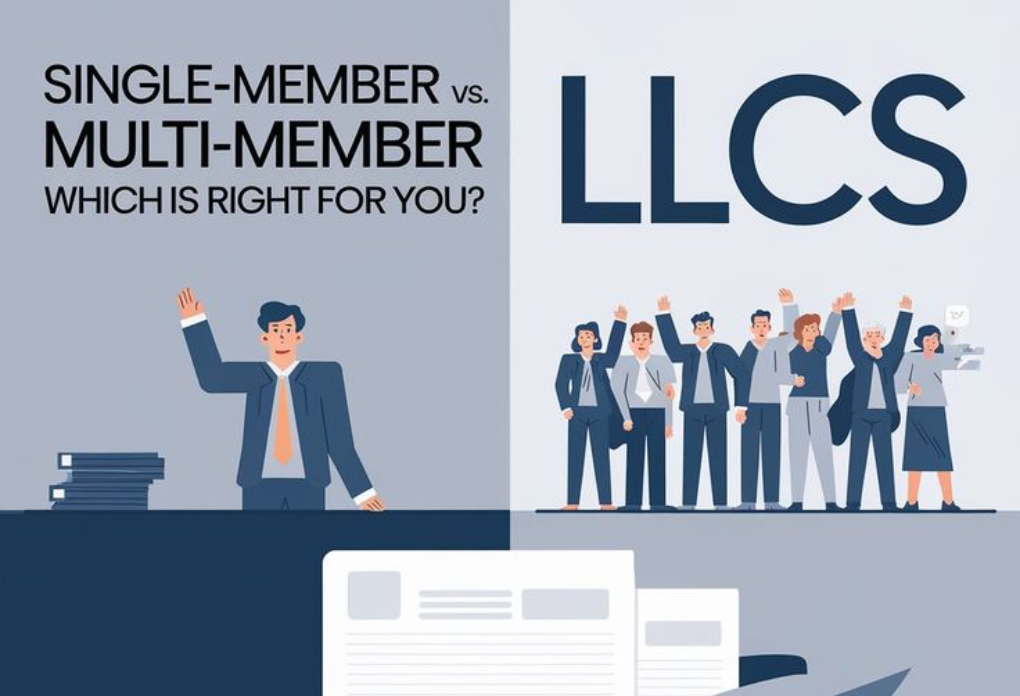Single-Member LLC vs. Multi-Member LLC: Which is Right for You?
When launching a business in the United States, choosing the Limited Liability Company (LLC) structure is a popular first step. It provides the crucial benefit of personal liability protection, separating your personal assets from your business debts. However, the next critical decision you’ll face is whether to form the LLC as a solo owner or with partners.
This choice determines whether you have a Single-Member LLC (SMLLC) or a Multi-Member LLC (MMLLC). While both offer the same liability shield, they differ significantly in management, taxation, and legal requirements. Understanding these differences is key to building a solid foundation for your business.
Management & Decision-Making
How your business is run day-to-day is one of the most immediate differences between the two structures.
- Single-Member LLC:
As the sole owner, you have complete and undisputed control. All decisions, from major strategic pivots to minor operational details, are yours to make. This offers ultimate agility and simplicity. There’s no need for formal votes or partner meetings. The downside is that all responsibility rests solely on your shoulders. - Multi-Member LLC:
Management is a collaborative effort. Decisions are made by the members according to the rules laid out in the LLC’s Operating Agreement. This agreement is crucial and specifies whether decisions require a majority vote or unanimous consent. While this brings more brainpower and shared responsibility to the table, it also carries the risk of disputes if members disagree.
Federal Income Taxation
The Internal Revenue Service (IRS) treats SMLLCs and MMLLCs very differently by default.
- Single-Member LLC: “Disregarded Entity”
By default, the IRS treats an SMLLC as a “disregarded entity.” This means the LLC itself does not file a separate federal income tax return. Instead, all profits and losses are “passed through” to the owner, who reports them on their personal tax return (Form 1040) using Schedule C, Profit or Loss from Business. This is identical to how a sole proprietorship is taxed. - Multi-Member LLC: Partnership
A Multi-Member LLC is taxed as a partnership by default. The LLC must file an annual informational tax return with the IRS (Form 1065, U.S. Return of Partnership Income). The LLC itself does not pay taxes. Instead, it issues a Schedule K-1 to each member, detailing their individual share of the company’s profits and losses. Each member then reports this information on their personal tax return.
The S Corp Election: Both SMLLCs and MMLLCs have the option to elect to be taxed as an S Corporation. This can potentially offer self-employment tax savings for profitable businesses but comes with stricter administrative rules, such as running payroll and paying owners a “reasonable salary.”
Legal & Administrative Formalities
The paperwork and internal governance requirements also vary.
- Single-Member LLC:
Formation requires filing the Articles of Organization with the state. While not always mandatory, creating an Operating Agreement is highly recommended even for a single owner. It helps prove the LLC is a separate legal entity, strengthening your liability protection. - Multi-Member LLC:
An Operating Agreement is absolutely essential for a Multi-Member LLC. This legally binding document is the contract between the members and should clearly define:- The percentage of ownership for each member.
- Each member’s roles and responsibilities.
- How profits and losses will be distributed.
- Voting rights and decision-making processes.
- A buy-sell provision, which outlines what happens if a member wants to leave, passes away, or becomes disabled.
At-a-Glance Comparison
| Feature | Single-Member LLC | Multi-Member LLC |
| Ownership | One owner (member). | Two or more owners (members). |
| Management | Owner has full control. | Managed by members as per the Operating Agreement. |
| Default Tax Status | Disregarded Entity (reported on owner’s personal return). | Partnership (LLC files informational return; members get K-1). |
| Key Document | Articles of Organization. | Articles of Organization & a comprehensive Operating Agreement. |
| Best For | Solo entrepreneurs, freelancers, and single consultants. | Co-founders, family businesses, and partner ventures. |
Which Structure is Right for Your Business?
- Choose a Single-Member LLC if:
- You are starting the business alone.
- You want 100% control and autonomy in your decision-making.
- You prefer the simplest tax and administrative structure.
- Choose a Multi-Member LLC if:
- You are starting the business with one or more partners.
- You need to pool capital, skills, or resources from multiple individuals.
- You want to define the rights and responsibilities of each co-owner legally.
Your Partner in Formation
Whether you’re a solo visionary or building a team of co-founders, the right LLC structure is waiting for you. The choice between a Single-Member and Multi-Member LLC shapes how you manage, tax, and grow your business for years to come.
The process involves important legal and financial decisions. At Empire Ecommerce, we specialize in forming both Single-Member and Multi-Member LLCs. We’ll handle the paperwork and guide you through the process, ensuring your business is set up for success from day one, no matter which path you choose.
Ready to establish your U.S. company? Contact Empire Ecommerce for a free consultation and let our experts build the perfect LLC structure for your business goals.







